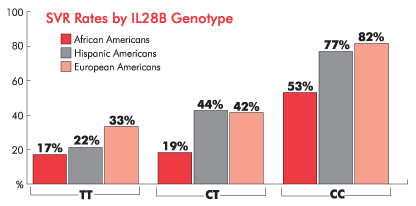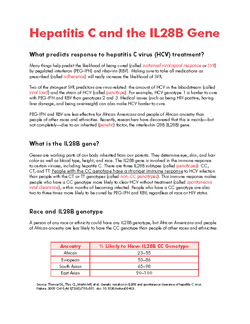April 2013
What predicts response to hepatitis C virus (HCV) treatment?
Many things help predict the likelihood of being cured (called sustained virological response or SVR) by pegylated interferon (PEG-IFN) and ribavirin (RBV). Making sure to take all medications as prescribed (called adherence) will really increase the likelihood of SVR.
Two of the strongest SVR predictors are virus-related: the amount of HCV in the bloodstream (called viral load) and the strain of HCV (called genotype). For example, HCV genotype 1 is harder to cure with PEG-IFN and RBV than genotypes 2 and 3. Medical issues (such as being HIV-positive, having liver damage, and being overweight) can also make HCV harder to cure.
PEG-IFN and RBV are less effective for African Americans and people of African ancestry than people of other races and ethnicities. Recently, researchers have discovered that this is mainly—but not completely—due to an inherited (genetic) factor, the interleukin-28B (IL28B) gene.
What is the IL28B gene?
Genes are working parts of our body inherited from our parents. They determine eye, skin, and hair color as well as blood type, height, and race. The IL28B gene is involved in the immune response to certain viruses, including hepatitis C. There are three IL28B subtypes (called genotypes): CC, CT, and TT. People with the CC genotype have a stronger immune response to HCV infection than people with the CT or TT genotypes (called non-CC genotypes). This immune response makes people who have a CC genotype more likely to clear HCV without treatment (called spontaneous viral clearance), within months of becoming infected. People who have a CC genotype are also two to three times more likely to be cured by PEG-IFN and RBV, regardless of race or HIV status.
Race and IL28B genotype
A person of any race or ethnicity could have any IL28B genotype, but African Americans and people of African ancestry are less likely to have the CC genotype than people of other races and ethnicities.

Source: Thomas DL, Thio CL, Martin MP, et al. Genetic variation in IL28B and spontaneous clearance of hepatitis C virus. Nature. 2009 Oct 8;461(7265):798–801. doi: 10.1038/nature08463.
Although people with the CC genotype are more likely to be cured by PEG-IFN and RBV, race still influences the likelihood of being cured. SVR rates among people with the CC genotype are lower in African Americans and people of African ancestry than in people of other races. Researchers have not discovered other factors to explain the difference in SVR rates.

Adapted from Ge D, Fellay J, Thompson AJ, et al. Genetic variation in IL28B predicts hepatitis C treatment-induced viral clearance. Nature. 2009 Sep 17;461(7262):399-401. doi: 10.1038/nature08309.
IL28B and new HCV drugs
Adding one of the new oral HCV drugs (called direct-acting antivirals or DAAs) to PEG-IFN and RBV or using a combination of DAAs will increase SVR rates in people with non-CC genotypes, regardless of race or ethnicity. It is still unclear whether IL28B genotype has a strong influence on cure rates from DAAs without PEG-IFN, or which DAAs are best for people with non-CC genotypes.
Regardless of your IL28B genotype, it is important to get a viral load test 4 or 12 weeks after starting HCV treatment, to see if it is working. People with an undetectable hepatitis C viral load at 4 or 12 weeks are more likely to be cured, especially if they have the IL28B CC genotype.
How can I find out my IL28B genotype?
You can take a blood test to learn your IL28B genotype (called the IL28B genotype test). You only need to take this test once, because your IL28B genotype never changes.
- IL28B genotype may determine the type—and possibly length—of your HCV treatment. It can be important information for treatment decision-making.
- A person’s IL28B genotype should never be used to withhold HCV treatment, since people with non-CC genotypes can also be cured.
- Soon, there will be more information about the best treatments for people with non-CC genotypes. Check with your medical providers.

